University MBA Strategy Investigation: Business Models and Strategy
VerifiedAdded on 2022/09/22
|16
|3481
|38
Report
AI Summary
This report provides a comprehensive investigation into the shift from traditional strategy formulation to the adoption of business models in the contemporary business environment. It begins by defining strategy and exploring the traditional approach to strategy formulation, including its key steps and tools like PEST and SWOT analysis, while also highlighting its limitations in the modern context. The report then delves into the concept of business models, discussing their effectiveness and how they address the shortcomings of traditional approaches. It examines various business model types and emphasizes their flexibility and adaptability. Furthermore, the report explores recent approaches to strategy formulation, focusing on demand-side strategy and its emphasis on value creation for consumers. By analyzing the evolution of business models and strategy, this report provides valuable insights into effective strategic management in today's dynamic business landscape.

Running head: STRATEGY INVESTIGATION
Strategy Investigation
Name of the Student
Name of the University
Authors note
Strategy Investigation
Name of the Student
Name of the University
Authors note
Paraphrase This Document
Need a fresh take? Get an instant paraphrase of this document with our AI Paraphraser
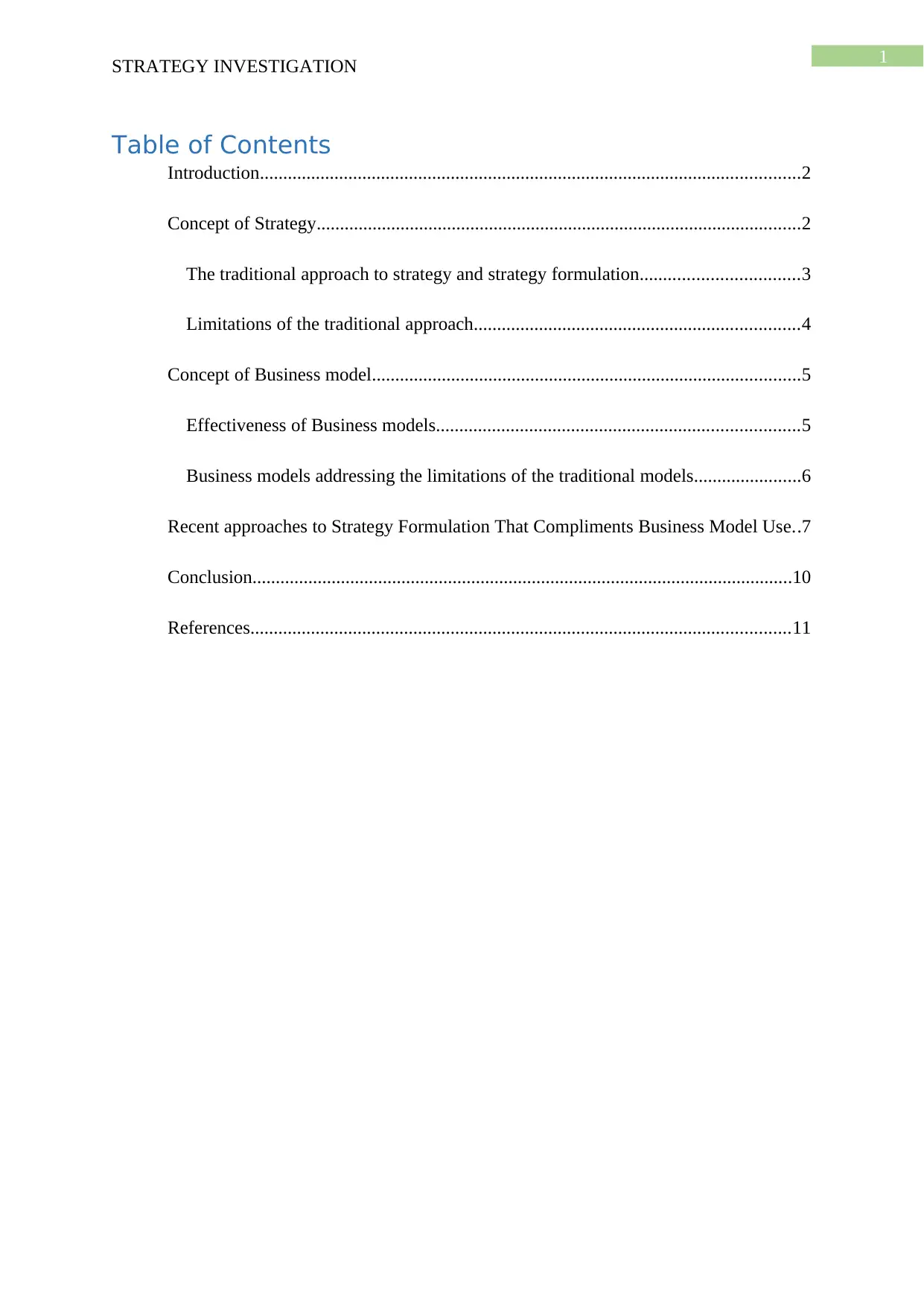
1
STRATEGY INVESTIGATION
Table of Contents
Introduction....................................................................................................................2
Concept of Strategy........................................................................................................2
The traditional approach to strategy and strategy formulation..................................3
Limitations of the traditional approach......................................................................4
Concept of Business model............................................................................................5
Effectiveness of Business models..............................................................................5
Business models addressing the limitations of the traditional models.......................6
Recent approaches to Strategy Formulation That Compliments Business Model Use..7
Conclusion....................................................................................................................10
References....................................................................................................................11
STRATEGY INVESTIGATION
Table of Contents
Introduction....................................................................................................................2
Concept of Strategy........................................................................................................2
The traditional approach to strategy and strategy formulation..................................3
Limitations of the traditional approach......................................................................4
Concept of Business model............................................................................................5
Effectiveness of Business models..............................................................................5
Business models addressing the limitations of the traditional models.......................6
Recent approaches to Strategy Formulation That Compliments Business Model Use..7
Conclusion....................................................................................................................10
References....................................................................................................................11
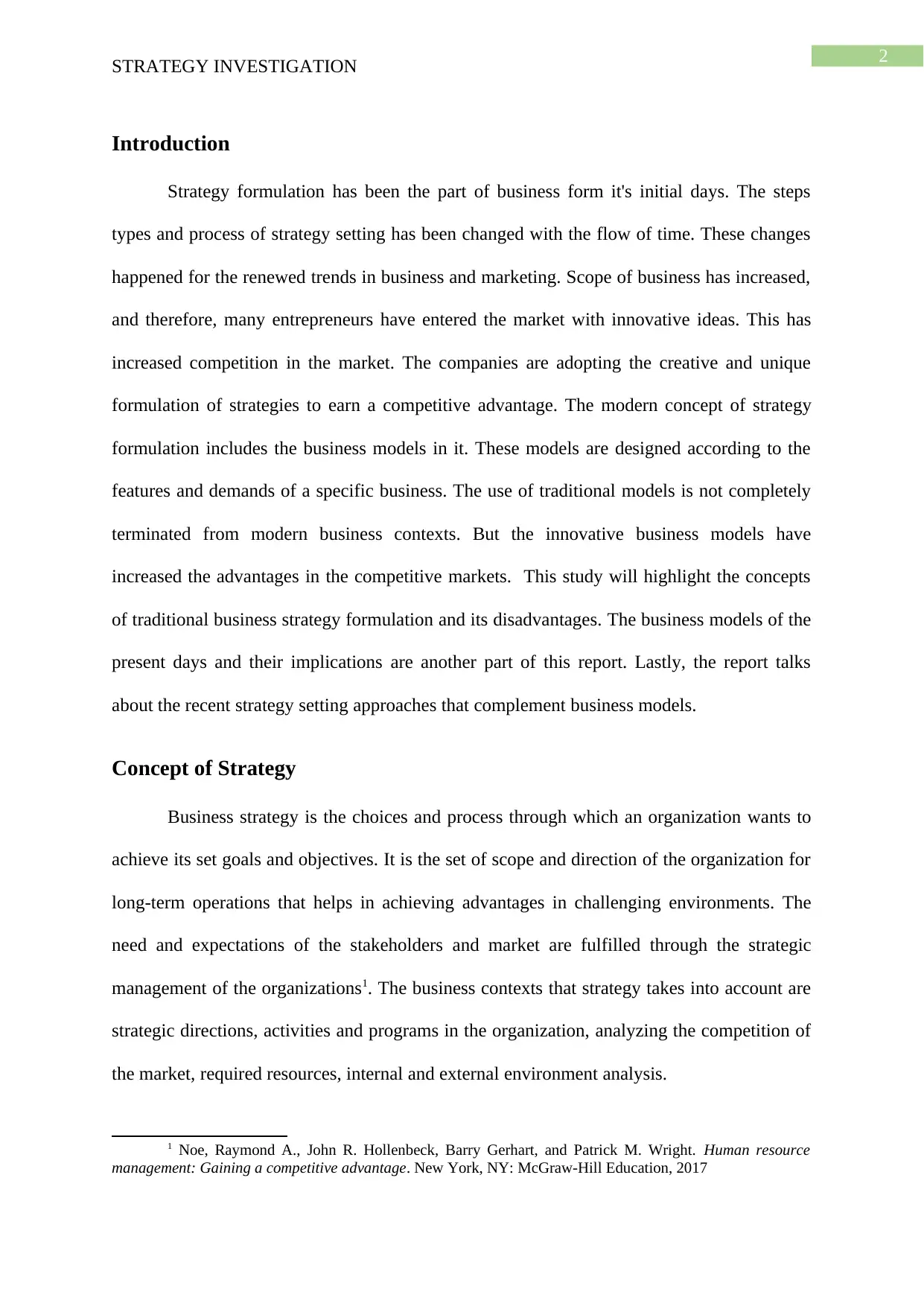
2
STRATEGY INVESTIGATION
Introduction
Strategy formulation has been the part of business form it's initial days. The steps
types and process of strategy setting has been changed with the flow of time. These changes
happened for the renewed trends in business and marketing. Scope of business has increased,
and therefore, many entrepreneurs have entered the market with innovative ideas. This has
increased competition in the market. The companies are adopting the creative and unique
formulation of strategies to earn a competitive advantage. The modern concept of strategy
formulation includes the business models in it. These models are designed according to the
features and demands of a specific business. The use of traditional models is not completely
terminated from modern business contexts. But the innovative business models have
increased the advantages in the competitive markets. This study will highlight the concepts
of traditional business strategy formulation and its disadvantages. The business models of the
present days and their implications are another part of this report. Lastly, the report talks
about the recent strategy setting approaches that complement business models.
Concept of Strategy
Business strategy is the choices and process through which an organization wants to
achieve its set goals and objectives. It is the set of scope and direction of the organization for
long-term operations that helps in achieving advantages in challenging environments. The
need and expectations of the stakeholders and market are fulfilled through the strategic
management of the organizations1. The business contexts that strategy takes into account are
strategic directions, activities and programs in the organization, analyzing the competition of
the market, required resources, internal and external environment analysis.
1 Noe, Raymond A., John R. Hollenbeck, Barry Gerhart, and Patrick M. Wright. Human resource
management: Gaining a competitive advantage. New York, NY: McGraw-Hill Education, 2017
STRATEGY INVESTIGATION
Introduction
Strategy formulation has been the part of business form it's initial days. The steps
types and process of strategy setting has been changed with the flow of time. These changes
happened for the renewed trends in business and marketing. Scope of business has increased,
and therefore, many entrepreneurs have entered the market with innovative ideas. This has
increased competition in the market. The companies are adopting the creative and unique
formulation of strategies to earn a competitive advantage. The modern concept of strategy
formulation includes the business models in it. These models are designed according to the
features and demands of a specific business. The use of traditional models is not completely
terminated from modern business contexts. But the innovative business models have
increased the advantages in the competitive markets. This study will highlight the concepts
of traditional business strategy formulation and its disadvantages. The business models of the
present days and their implications are another part of this report. Lastly, the report talks
about the recent strategy setting approaches that complement business models.
Concept of Strategy
Business strategy is the choices and process through which an organization wants to
achieve its set goals and objectives. It is the set of scope and direction of the organization for
long-term operations that helps in achieving advantages in challenging environments. The
need and expectations of the stakeholders and market are fulfilled through the strategic
management of the organizations1. The business contexts that strategy takes into account are
strategic directions, activities and programs in the organization, analyzing the competition of
the market, required resources, internal and external environment analysis.
1 Noe, Raymond A., John R. Hollenbeck, Barry Gerhart, and Patrick M. Wright. Human resource
management: Gaining a competitive advantage. New York, NY: McGraw-Hill Education, 2017
⊘ This is a preview!⊘
Do you want full access?
Subscribe today to unlock all pages.

Trusted by 1+ million students worldwide
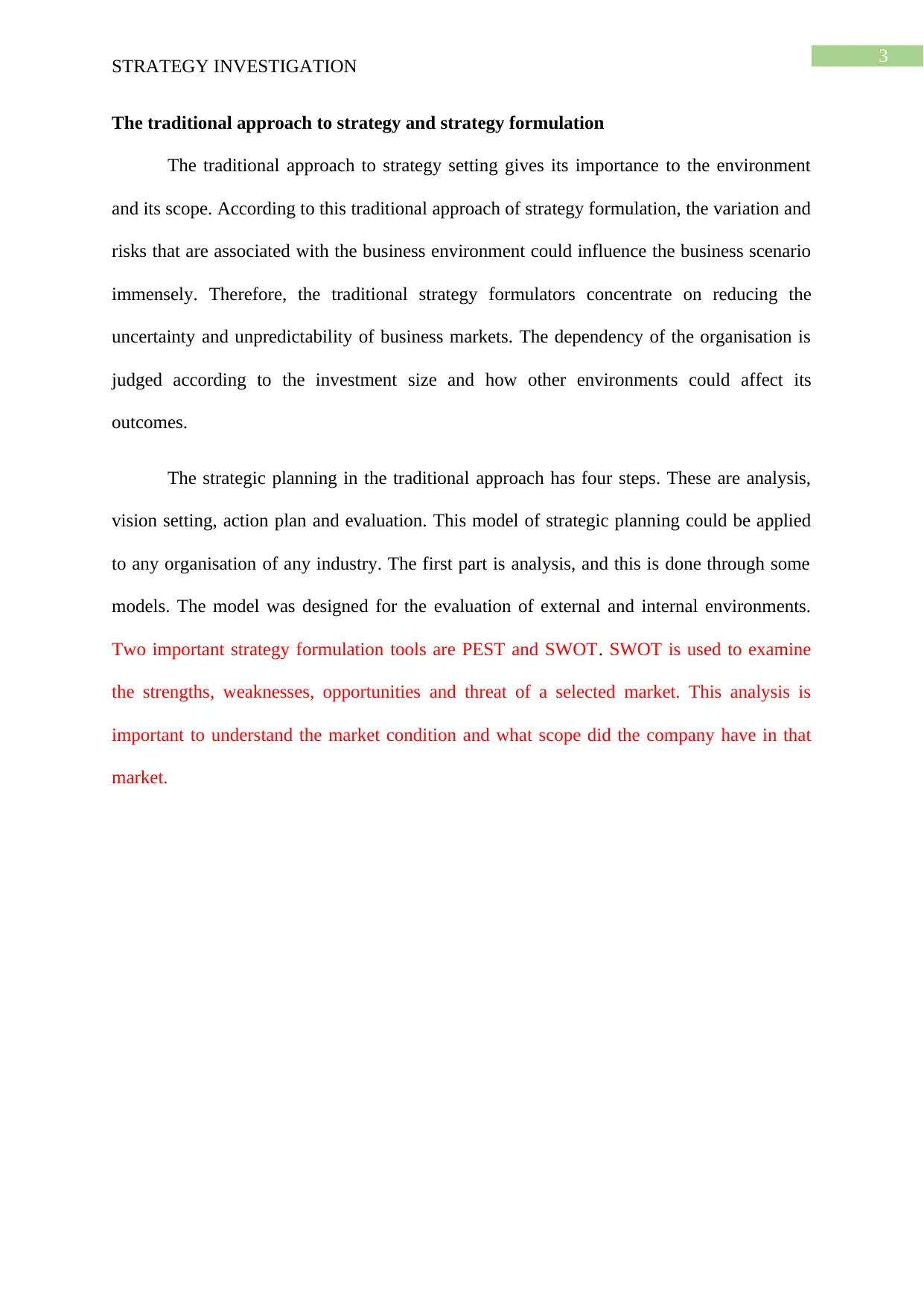
3
STRATEGY INVESTIGATION
The traditional approach to strategy and strategy formulation
The traditional approach to strategy setting gives its importance to the environment
and its scope. According to this traditional approach of strategy formulation, the variation and
risks that are associated with the business environment could influence the business scenario
immensely. Therefore, the traditional strategy formulators concentrate on reducing the
uncertainty and unpredictability of business markets. The dependency of the organisation is
judged according to the investment size and how other environments could affect its
outcomes.
The strategic planning in the traditional approach has four steps. These are analysis,
vision setting, action plan and evaluation. This model of strategic planning could be applied
to any organisation of any industry. The first part is analysis, and this is done through some
models. The model was designed for the evaluation of external and internal environments.
Two important strategy formulation tools are PEST and SWOT. SWOT is used to examine
the strengths, weaknesses, opportunities and threat of a selected market. This analysis is
important to understand the market condition and what scope did the company have in that
market.
STRATEGY INVESTIGATION
The traditional approach to strategy and strategy formulation
The traditional approach to strategy setting gives its importance to the environment
and its scope. According to this traditional approach of strategy formulation, the variation and
risks that are associated with the business environment could influence the business scenario
immensely. Therefore, the traditional strategy formulators concentrate on reducing the
uncertainty and unpredictability of business markets. The dependency of the organisation is
judged according to the investment size and how other environments could affect its
outcomes.
The strategic planning in the traditional approach has four steps. These are analysis,
vision setting, action plan and evaluation. This model of strategic planning could be applied
to any organisation of any industry. The first part is analysis, and this is done through some
models. The model was designed for the evaluation of external and internal environments.
Two important strategy formulation tools are PEST and SWOT. SWOT is used to examine
the strengths, weaknesses, opportunities and threat of a selected market. This analysis is
important to understand the market condition and what scope did the company have in that
market.
Paraphrase This Document
Need a fresh take? Get an instant paraphrase of this document with our AI Paraphraser
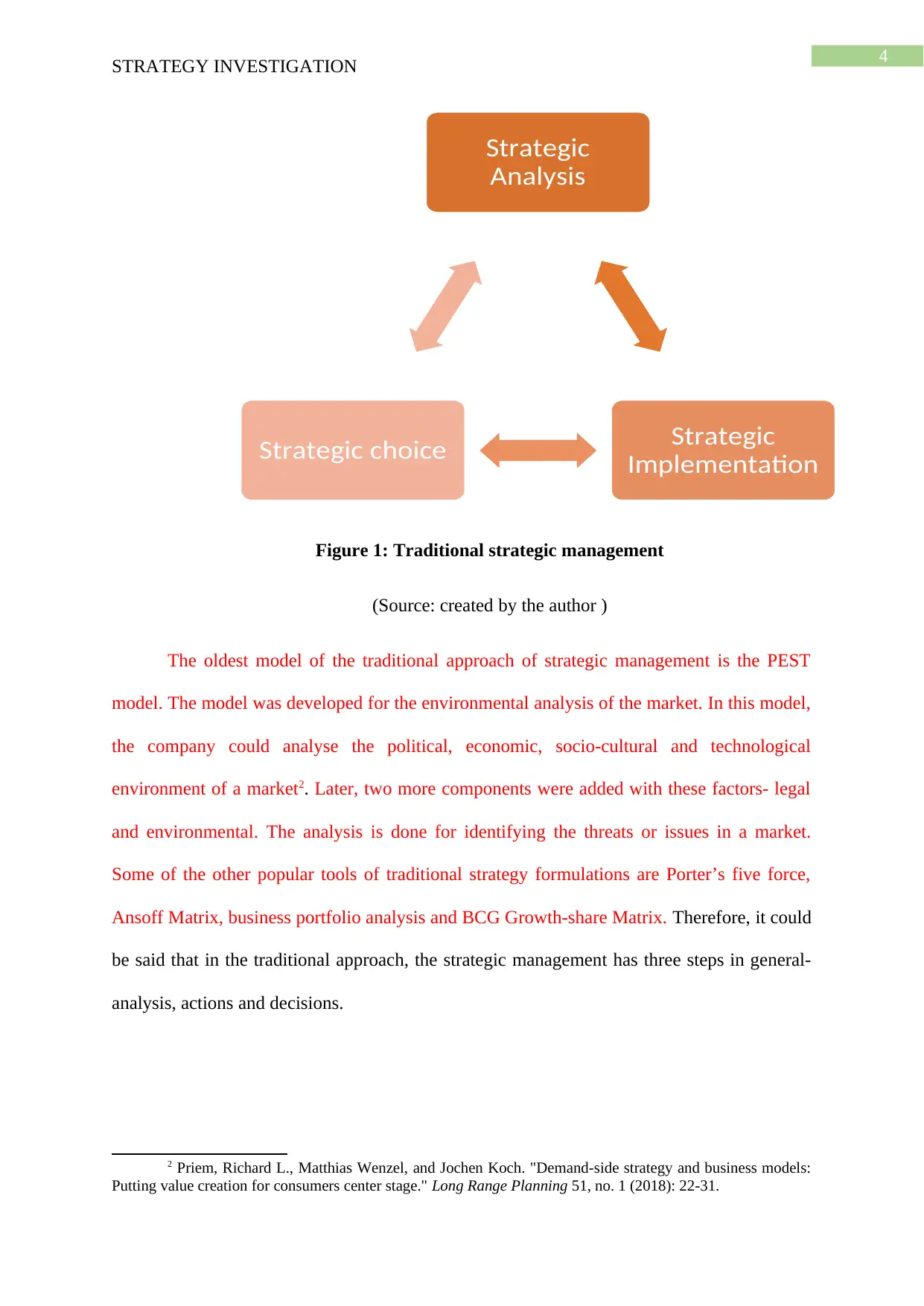
4
STRATEGY INVESTIGATION
Figure 1: Traditional strategic management
(Source: created by the author )
The oldest model of the traditional approach of strategic management is the PEST
model. The model was developed for the environmental analysis of the market. In this model,
the company could analyse the political, economic, socio-cultural and technological
environment of a market2. Later, two more components were added with these factors- legal
and environmental. The analysis is done for identifying the threats or issues in a market.
Some of the other popular tools of traditional strategy formulations are Porter’s five force,
Ansoff Matrix, business portfolio analysis and BCG Growth-share Matrix. Therefore, it could
be said that in the traditional approach, the strategic management has three steps in general-
analysis, actions and decisions.
2 Priem, Richard L., Matthias Wenzel, and Jochen Koch. "Demand-side strategy and business models:
Putting value creation for consumers center stage." Long Range Planning 51, no. 1 (2018): 22-31.
Strategic
Analysis
Strategic
Implementation
Strategic choice
STRATEGY INVESTIGATION
Figure 1: Traditional strategic management
(Source: created by the author )
The oldest model of the traditional approach of strategic management is the PEST
model. The model was developed for the environmental analysis of the market. In this model,
the company could analyse the political, economic, socio-cultural and technological
environment of a market2. Later, two more components were added with these factors- legal
and environmental. The analysis is done for identifying the threats or issues in a market.
Some of the other popular tools of traditional strategy formulations are Porter’s five force,
Ansoff Matrix, business portfolio analysis and BCG Growth-share Matrix. Therefore, it could
be said that in the traditional approach, the strategic management has three steps in general-
analysis, actions and decisions.
2 Priem, Richard L., Matthias Wenzel, and Jochen Koch. "Demand-side strategy and business models:
Putting value creation for consumers center stage." Long Range Planning 51, no. 1 (2018): 22-31.
Strategic
Analysis
Strategic
Implementation
Strategic choice
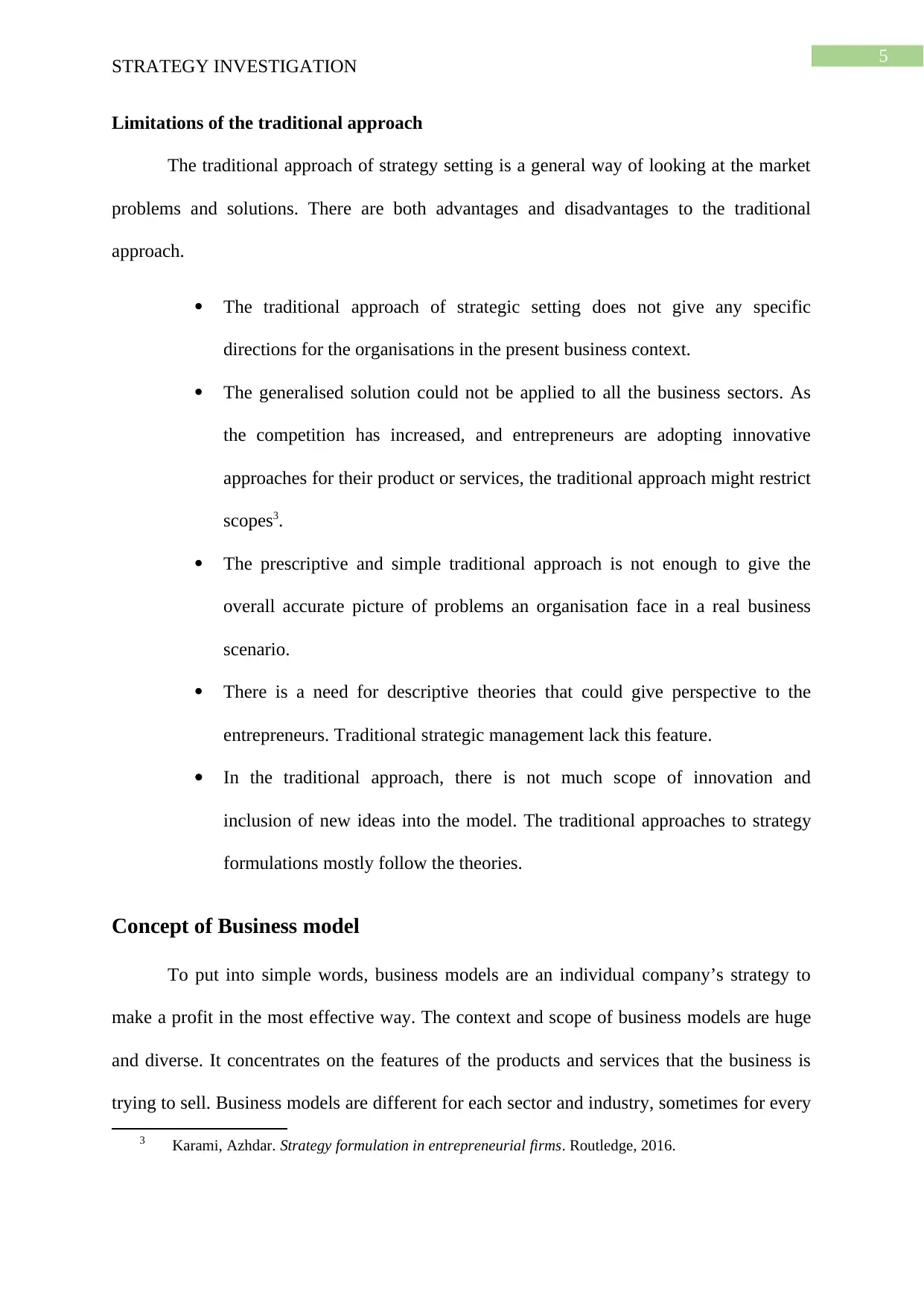
5
STRATEGY INVESTIGATION
Limitations of the traditional approach
The traditional approach of strategy setting is a general way of looking at the market
problems and solutions. There are both advantages and disadvantages to the traditional
approach.
The traditional approach of strategic setting does not give any specific
directions for the organisations in the present business context.
The generalised solution could not be applied to all the business sectors. As
the competition has increased, and entrepreneurs are adopting innovative
approaches for their product or services, the traditional approach might restrict
scopes3.
The prescriptive and simple traditional approach is not enough to give the
overall accurate picture of problems an organisation face in a real business
scenario.
There is a need for descriptive theories that could give perspective to the
entrepreneurs. Traditional strategic management lack this feature.
In the traditional approach, there is not much scope of innovation and
inclusion of new ideas into the model. The traditional approaches to strategy
formulations mostly follow the theories.
Concept of Business model
To put into simple words, business models are an individual company’s strategy to
make a profit in the most effective way. The context and scope of business models are huge
and diverse. It concentrates on the features of the products and services that the business is
trying to sell. Business models are different for each sector and industry, sometimes for every
3 Karami, Azhdar. Strategy formulation in entrepreneurial firms. Routledge, 2016.
STRATEGY INVESTIGATION
Limitations of the traditional approach
The traditional approach of strategy setting is a general way of looking at the market
problems and solutions. There are both advantages and disadvantages to the traditional
approach.
The traditional approach of strategic setting does not give any specific
directions for the organisations in the present business context.
The generalised solution could not be applied to all the business sectors. As
the competition has increased, and entrepreneurs are adopting innovative
approaches for their product or services, the traditional approach might restrict
scopes3.
The prescriptive and simple traditional approach is not enough to give the
overall accurate picture of problems an organisation face in a real business
scenario.
There is a need for descriptive theories that could give perspective to the
entrepreneurs. Traditional strategic management lack this feature.
In the traditional approach, there is not much scope of innovation and
inclusion of new ideas into the model. The traditional approaches to strategy
formulations mostly follow the theories.
Concept of Business model
To put into simple words, business models are an individual company’s strategy to
make a profit in the most effective way. The context and scope of business models are huge
and diverse. It concentrates on the features of the products and services that the business is
trying to sell. Business models are different for each sector and industry, sometimes for every
3 Karami, Azhdar. Strategy formulation in entrepreneurial firms. Routledge, 2016.
⊘ This is a preview!⊘
Do you want full access?
Subscribe today to unlock all pages.

Trusted by 1+ million students worldwide
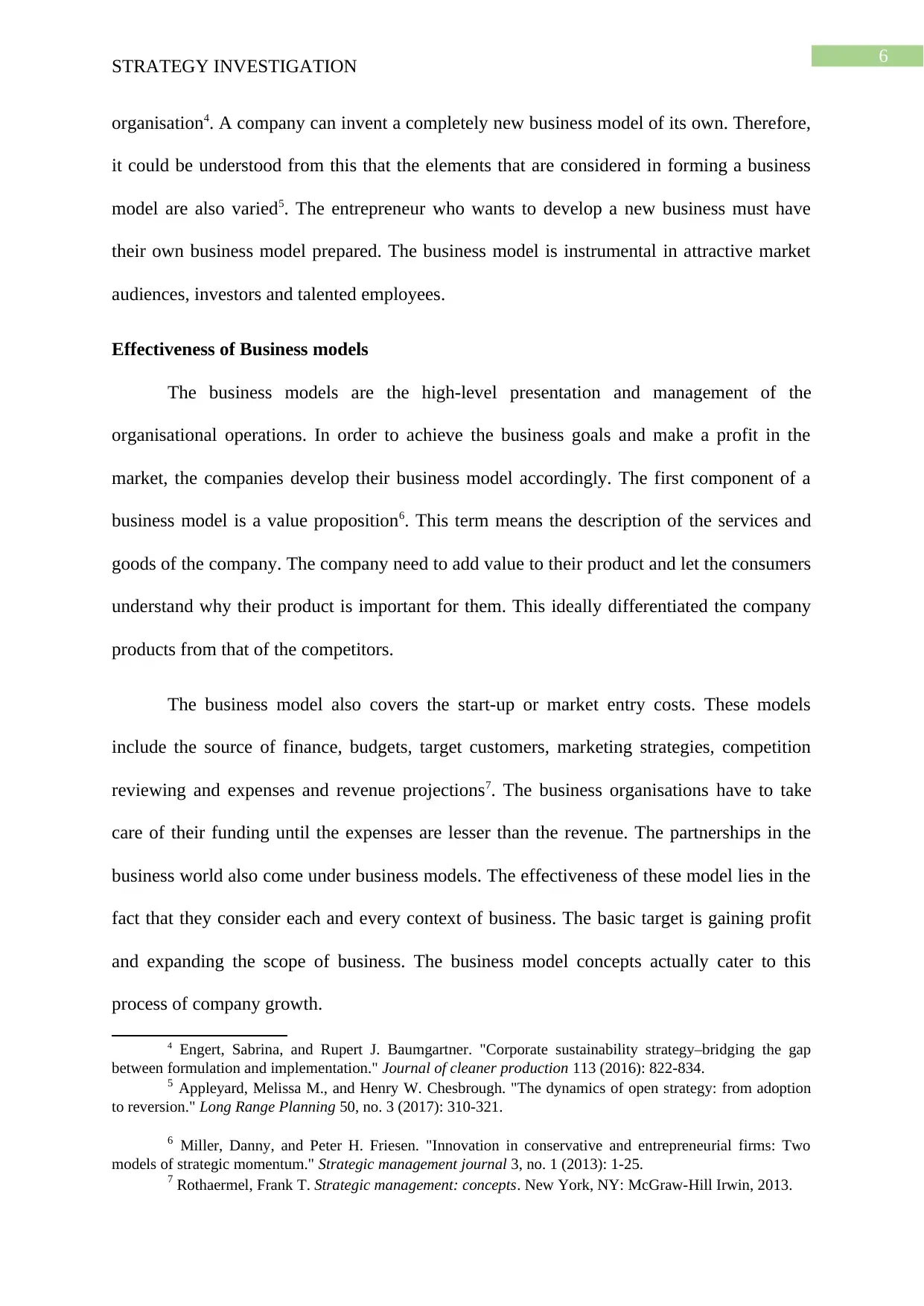
6
STRATEGY INVESTIGATION
organisation4. A company can invent a completely new business model of its own. Therefore,
it could be understood from this that the elements that are considered in forming a business
model are also varied5. The entrepreneur who wants to develop a new business must have
their own business model prepared. The business model is instrumental in attractive market
audiences, investors and talented employees.
Effectiveness of Business models
The business models are the high-level presentation and management of the
organisational operations. In order to achieve the business goals and make a profit in the
market, the companies develop their business model accordingly. The first component of a
business model is a value proposition6. This term means the description of the services and
goods of the company. The company need to add value to their product and let the consumers
understand why their product is important for them. This ideally differentiated the company
products from that of the competitors.
The business model also covers the start-up or market entry costs. These models
include the source of finance, budgets, target customers, marketing strategies, competition
reviewing and expenses and revenue projections7. The business organisations have to take
care of their funding until the expenses are lesser than the revenue. The partnerships in the
business world also come under business models. The effectiveness of these model lies in the
fact that they consider each and every context of business. The basic target is gaining profit
and expanding the scope of business. The business model concepts actually cater to this
process of company growth.
4 Engert, Sabrina, and Rupert J. Baumgartner. "Corporate sustainability strategy–bridging the gap
between formulation and implementation." Journal of cleaner production 113 (2016): 822-834.
5 Appleyard, Melissa M., and Henry W. Chesbrough. "The dynamics of open strategy: from adoption
to reversion." Long Range Planning 50, no. 3 (2017): 310-321.
6 Miller, Danny, and Peter H. Friesen. "Innovation in conservative and entrepreneurial firms: Two
models of strategic momentum." Strategic management journal 3, no. 1 (2013): 1-25.
7 Rothaermel, Frank T. Strategic management: concepts. New York, NY: McGraw-Hill Irwin, 2013.
STRATEGY INVESTIGATION
organisation4. A company can invent a completely new business model of its own. Therefore,
it could be understood from this that the elements that are considered in forming a business
model are also varied5. The entrepreneur who wants to develop a new business must have
their own business model prepared. The business model is instrumental in attractive market
audiences, investors and talented employees.
Effectiveness of Business models
The business models are the high-level presentation and management of the
organisational operations. In order to achieve the business goals and make a profit in the
market, the companies develop their business model accordingly. The first component of a
business model is a value proposition6. This term means the description of the services and
goods of the company. The company need to add value to their product and let the consumers
understand why their product is important for them. This ideally differentiated the company
products from that of the competitors.
The business model also covers the start-up or market entry costs. These models
include the source of finance, budgets, target customers, marketing strategies, competition
reviewing and expenses and revenue projections7. The business organisations have to take
care of their funding until the expenses are lesser than the revenue. The partnerships in the
business world also come under business models. The effectiveness of these model lies in the
fact that they consider each and every context of business. The basic target is gaining profit
and expanding the scope of business. The business model concepts actually cater to this
process of company growth.
4 Engert, Sabrina, and Rupert J. Baumgartner. "Corporate sustainability strategy–bridging the gap
between formulation and implementation." Journal of cleaner production 113 (2016): 822-834.
5 Appleyard, Melissa M., and Henry W. Chesbrough. "The dynamics of open strategy: from adoption
to reversion." Long Range Planning 50, no. 3 (2017): 310-321.
6 Miller, Danny, and Peter H. Friesen. "Innovation in conservative and entrepreneurial firms: Two
models of strategic momentum." Strategic management journal 3, no. 1 (2013): 1-25.
7 Rothaermel, Frank T. Strategic management: concepts. New York, NY: McGraw-Hill Irwin, 2013.
Paraphrase This Document
Need a fresh take? Get an instant paraphrase of this document with our AI Paraphraser
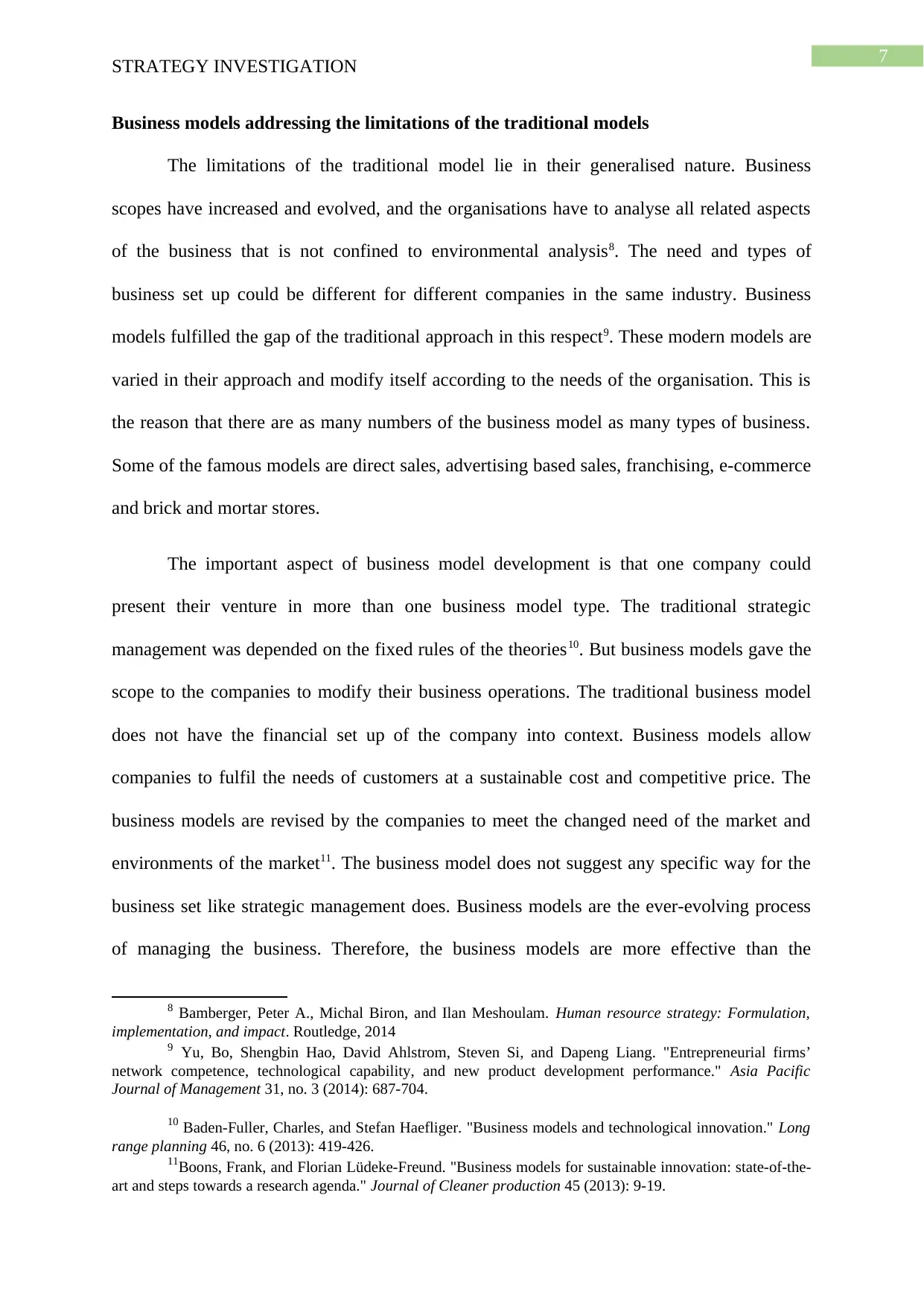
7
STRATEGY INVESTIGATION
Business models addressing the limitations of the traditional models
The limitations of the traditional model lie in their generalised nature. Business
scopes have increased and evolved, and the organisations have to analyse all related aspects
of the business that is not confined to environmental analysis8. The need and types of
business set up could be different for different companies in the same industry. Business
models fulfilled the gap of the traditional approach in this respect9. These modern models are
varied in their approach and modify itself according to the needs of the organisation. This is
the reason that there are as many numbers of the business model as many types of business.
Some of the famous models are direct sales, advertising based sales, franchising, e-commerce
and brick and mortar stores.
The important aspect of business model development is that one company could
present their venture in more than one business model type. The traditional strategic
management was depended on the fixed rules of the theories10. But business models gave the
scope to the companies to modify their business operations. The traditional business model
does not have the financial set up of the company into context. Business models allow
companies to fulfil the needs of customers at a sustainable cost and competitive price. The
business models are revised by the companies to meet the changed need of the market and
environments of the market11. The business model does not suggest any specific way for the
business set like strategic management does. Business models are the ever-evolving process
of managing the business. Therefore, the business models are more effective than the
8 Bamberger, Peter A., Michal Biron, and Ilan Meshoulam. Human resource strategy: Formulation,
implementation, and impact. Routledge, 2014
9 Yu, Bo, Shengbin Hao, David Ahlstrom, Steven Si, and Dapeng Liang. "Entrepreneurial firms’
network competence, technological capability, and new product development performance." Asia Pacific
Journal of Management 31, no. 3 (2014): 687-704.
10 Baden-Fuller, Charles, and Stefan Haefliger. "Business models and technological innovation." Long
range planning 46, no. 6 (2013): 419-426.
11Boons, Frank, and Florian Lüdeke-Freund. "Business models for sustainable innovation: state-of-the-
art and steps towards a research agenda." Journal of Cleaner production 45 (2013): 9-19.
STRATEGY INVESTIGATION
Business models addressing the limitations of the traditional models
The limitations of the traditional model lie in their generalised nature. Business
scopes have increased and evolved, and the organisations have to analyse all related aspects
of the business that is not confined to environmental analysis8. The need and types of
business set up could be different for different companies in the same industry. Business
models fulfilled the gap of the traditional approach in this respect9. These modern models are
varied in their approach and modify itself according to the needs of the organisation. This is
the reason that there are as many numbers of the business model as many types of business.
Some of the famous models are direct sales, advertising based sales, franchising, e-commerce
and brick and mortar stores.
The important aspect of business model development is that one company could
present their venture in more than one business model type. The traditional strategic
management was depended on the fixed rules of the theories10. But business models gave the
scope to the companies to modify their business operations. The traditional business model
does not have the financial set up of the company into context. Business models allow
companies to fulfil the needs of customers at a sustainable cost and competitive price. The
business models are revised by the companies to meet the changed need of the market and
environments of the market11. The business model does not suggest any specific way for the
business set like strategic management does. Business models are the ever-evolving process
of managing the business. Therefore, the business models are more effective than the
8 Bamberger, Peter A., Michal Biron, and Ilan Meshoulam. Human resource strategy: Formulation,
implementation, and impact. Routledge, 2014
9 Yu, Bo, Shengbin Hao, David Ahlstrom, Steven Si, and Dapeng Liang. "Entrepreneurial firms’
network competence, technological capability, and new product development performance." Asia Pacific
Journal of Management 31, no. 3 (2014): 687-704.
10 Baden-Fuller, Charles, and Stefan Haefliger. "Business models and technological innovation." Long
range planning 46, no. 6 (2013): 419-426.
11Boons, Frank, and Florian Lüdeke-Freund. "Business models for sustainable innovation: state-of-the-
art and steps towards a research agenda." Journal of Cleaner production 45 (2013): 9-19.
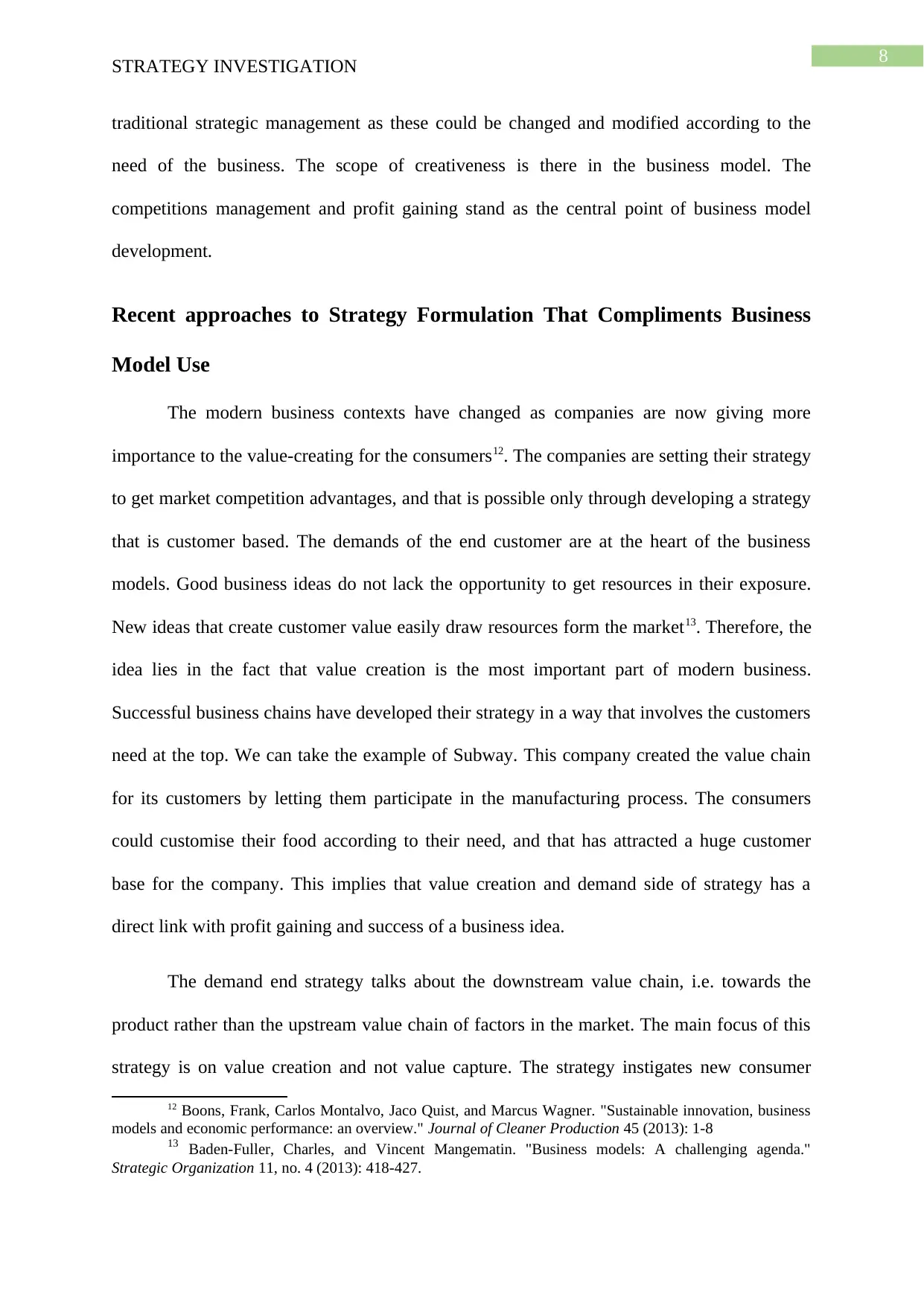
8
STRATEGY INVESTIGATION
traditional strategic management as these could be changed and modified according to the
need of the business. The scope of creativeness is there in the business model. The
competitions management and profit gaining stand as the central point of business model
development.
Recent approaches to Strategy Formulation That Compliments Business
Model Use
The modern business contexts have changed as companies are now giving more
importance to the value-creating for the consumers12. The companies are setting their strategy
to get market competition advantages, and that is possible only through developing a strategy
that is customer based. The demands of the end customer are at the heart of the business
models. Good business ideas do not lack the opportunity to get resources in their exposure.
New ideas that create customer value easily draw resources form the market13. Therefore, the
idea lies in the fact that value creation is the most important part of modern business.
Successful business chains have developed their strategy in a way that involves the customers
need at the top. We can take the example of Subway. This company created the value chain
for its customers by letting them participate in the manufacturing process. The consumers
could customise their food according to their need, and that has attracted a huge customer
base for the company. This implies that value creation and demand side of strategy has a
direct link with profit gaining and success of a business idea.
The demand end strategy talks about the downstream value chain, i.e. towards the
product rather than the upstream value chain of factors in the market. The main focus of this
strategy is on value creation and not value capture. The strategy instigates new consumer
12 Boons, Frank, Carlos Montalvo, Jaco Quist, and Marcus Wagner. "Sustainable innovation, business
models and economic performance: an overview." Journal of Cleaner Production 45 (2013): 1-8
13 Baden-Fuller, Charles, and Vincent Mangematin. "Business models: A challenging agenda."
Strategic Organization 11, no. 4 (2013): 418-427.
STRATEGY INVESTIGATION
traditional strategic management as these could be changed and modified according to the
need of the business. The scope of creativeness is there in the business model. The
competitions management and profit gaining stand as the central point of business model
development.
Recent approaches to Strategy Formulation That Compliments Business
Model Use
The modern business contexts have changed as companies are now giving more
importance to the value-creating for the consumers12. The companies are setting their strategy
to get market competition advantages, and that is possible only through developing a strategy
that is customer based. The demands of the end customer are at the heart of the business
models. Good business ideas do not lack the opportunity to get resources in their exposure.
New ideas that create customer value easily draw resources form the market13. Therefore, the
idea lies in the fact that value creation is the most important part of modern business.
Successful business chains have developed their strategy in a way that involves the customers
need at the top. We can take the example of Subway. This company created the value chain
for its customers by letting them participate in the manufacturing process. The consumers
could customise their food according to their need, and that has attracted a huge customer
base for the company. This implies that value creation and demand side of strategy has a
direct link with profit gaining and success of a business idea.
The demand end strategy talks about the downstream value chain, i.e. towards the
product rather than the upstream value chain of factors in the market. The main focus of this
strategy is on value creation and not value capture. The strategy instigates new consumer
12 Boons, Frank, Carlos Montalvo, Jaco Quist, and Marcus Wagner. "Sustainable innovation, business
models and economic performance: an overview." Journal of Cleaner Production 45 (2013): 1-8
13 Baden-Fuller, Charles, and Vincent Mangematin. "Business models: A challenging agenda."
Strategic Organization 11, no. 4 (2013): 418-427.
⊘ This is a preview!⊘
Do you want full access?
Subscribe today to unlock all pages.

Trusted by 1+ million students worldwide
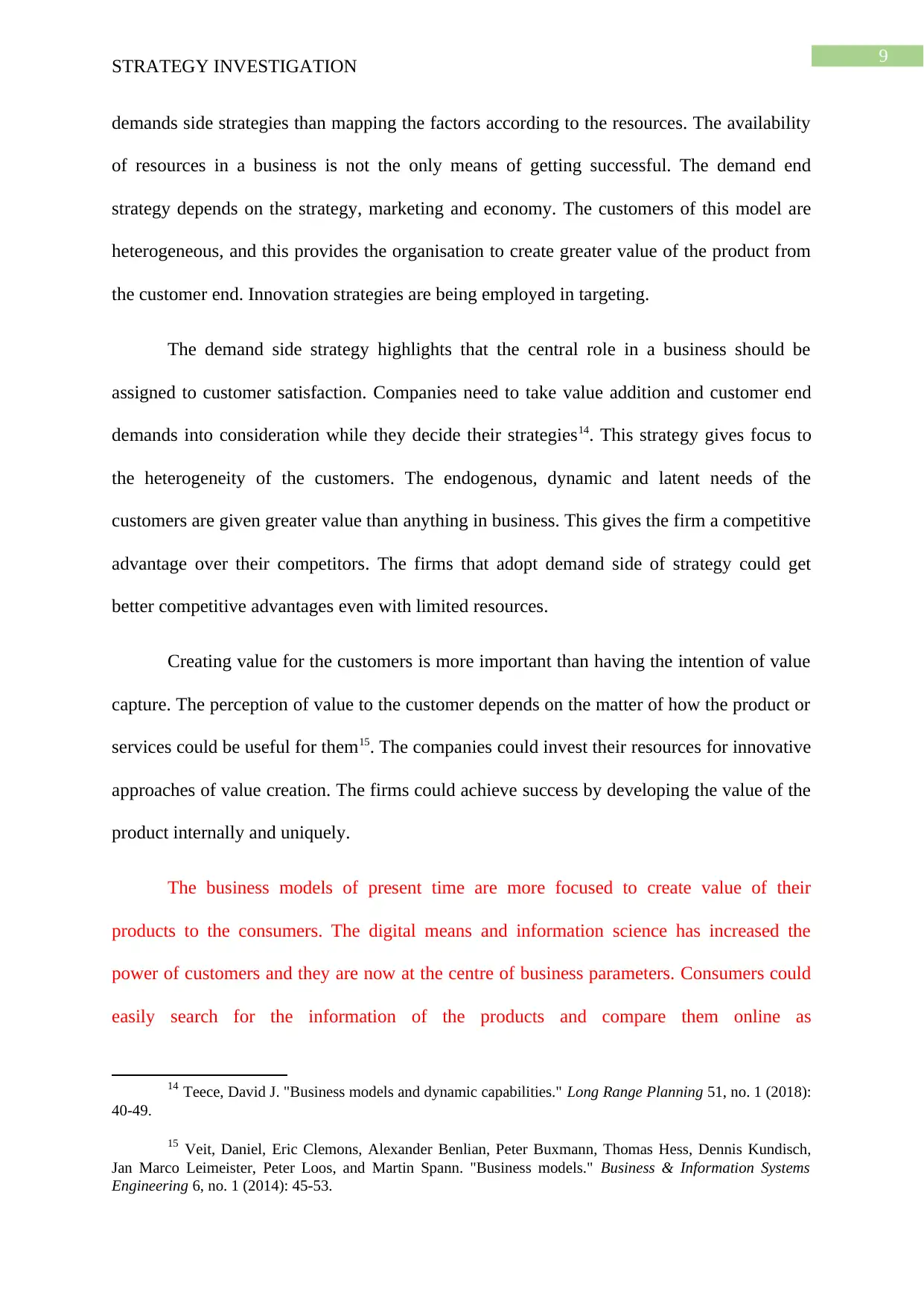
9
STRATEGY INVESTIGATION
demands side strategies than mapping the factors according to the resources. The availability
of resources in a business is not the only means of getting successful. The demand end
strategy depends on the strategy, marketing and economy. The customers of this model are
heterogeneous, and this provides the organisation to create greater value of the product from
the customer end. Innovation strategies are being employed in targeting.
The demand side strategy highlights that the central role in a business should be
assigned to customer satisfaction. Companies need to take value addition and customer end
demands into consideration while they decide their strategies14. This strategy gives focus to
the heterogeneity of the customers. The endogenous, dynamic and latent needs of the
customers are given greater value than anything in business. This gives the firm a competitive
advantage over their competitors. The firms that adopt demand side of strategy could get
better competitive advantages even with limited resources.
Creating value for the customers is more important than having the intention of value
capture. The perception of value to the customer depends on the matter of how the product or
services could be useful for them15. The companies could invest their resources for innovative
approaches of value creation. The firms could achieve success by developing the value of the
product internally and uniquely.
The business models of present time are more focused to create value of their
products to the consumers. The digital means and information science has increased the
power of customers and they are now at the centre of business parameters. Consumers could
easily search for the information of the products and compare them online as
14 Teece, David J. "Business models and dynamic capabilities." Long Range Planning 51, no. 1 (2018):
40-49.
15 Veit, Daniel, Eric Clemons, Alexander Benlian, Peter Buxmann, Thomas Hess, Dennis Kundisch,
Jan Marco Leimeister, Peter Loos, and Martin Spann. "Business models." Business & Information Systems
Engineering 6, no. 1 (2014): 45-53.
STRATEGY INVESTIGATION
demands side strategies than mapping the factors according to the resources. The availability
of resources in a business is not the only means of getting successful. The demand end
strategy depends on the strategy, marketing and economy. The customers of this model are
heterogeneous, and this provides the organisation to create greater value of the product from
the customer end. Innovation strategies are being employed in targeting.
The demand side strategy highlights that the central role in a business should be
assigned to customer satisfaction. Companies need to take value addition and customer end
demands into consideration while they decide their strategies14. This strategy gives focus to
the heterogeneity of the customers. The endogenous, dynamic and latent needs of the
customers are given greater value than anything in business. This gives the firm a competitive
advantage over their competitors. The firms that adopt demand side of strategy could get
better competitive advantages even with limited resources.
Creating value for the customers is more important than having the intention of value
capture. The perception of value to the customer depends on the matter of how the product or
services could be useful for them15. The companies could invest their resources for innovative
approaches of value creation. The firms could achieve success by developing the value of the
product internally and uniquely.
The business models of present time are more focused to create value of their
products to the consumers. The digital means and information science has increased the
power of customers and they are now at the centre of business parameters. Consumers could
easily search for the information of the products and compare them online as
14 Teece, David J. "Business models and dynamic capabilities." Long Range Planning 51, no. 1 (2018):
40-49.
15 Veit, Daniel, Eric Clemons, Alexander Benlian, Peter Buxmann, Thomas Hess, Dennis Kundisch,
Jan Marco Leimeister, Peter Loos, and Martin Spann. "Business models." Business & Information Systems
Engineering 6, no. 1 (2014): 45-53.
Paraphrase This Document
Need a fresh take? Get an instant paraphrase of this document with our AI Paraphraser
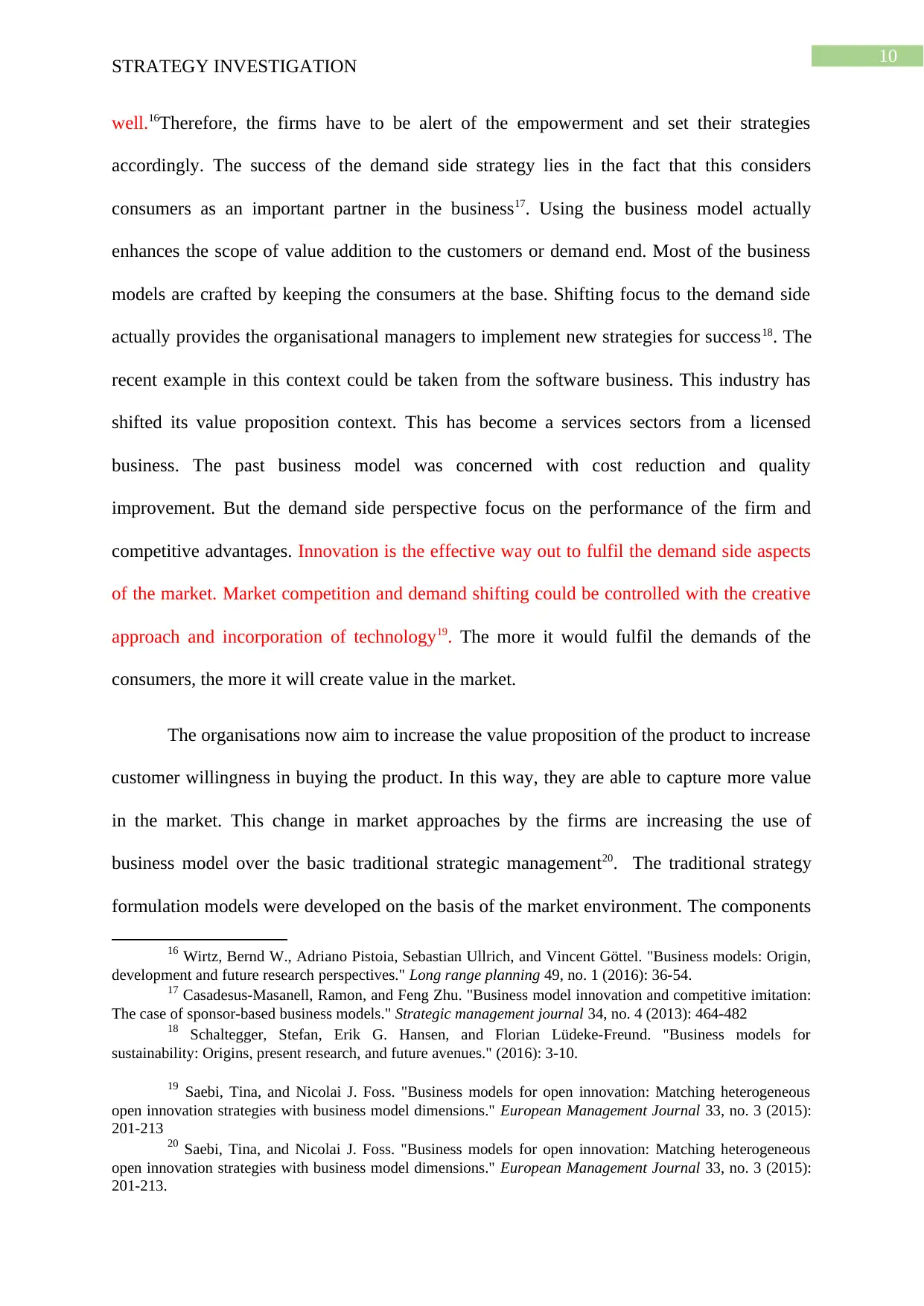
10
STRATEGY INVESTIGATION
well.16Therefore, the firms have to be alert of the empowerment and set their strategies
accordingly. The success of the demand side strategy lies in the fact that this considers
consumers as an important partner in the business17. Using the business model actually
enhances the scope of value addition to the customers or demand end. Most of the business
models are crafted by keeping the consumers at the base. Shifting focus to the demand side
actually provides the organisational managers to implement new strategies for success18. The
recent example in this context could be taken from the software business. This industry has
shifted its value proposition context. This has become a services sectors from a licensed
business. The past business model was concerned with cost reduction and quality
improvement. But the demand side perspective focus on the performance of the firm and
competitive advantages. Innovation is the effective way out to fulfil the demand side aspects
of the market. Market competition and demand shifting could be controlled with the creative
approach and incorporation of technology19. The more it would fulfil the demands of the
consumers, the more it will create value in the market.
The organisations now aim to increase the value proposition of the product to increase
customer willingness in buying the product. In this way, they are able to capture more value
in the market. This change in market approaches by the firms are increasing the use of
business model over the basic traditional strategic management20. The traditional strategy
formulation models were developed on the basis of the market environment. The components
16 Wirtz, Bernd W., Adriano Pistoia, Sebastian Ullrich, and Vincent Göttel. "Business models: Origin,
development and future research perspectives." Long range planning 49, no. 1 (2016): 36-54.
17 Casadesus‐Masanell, Ramon, and Feng Zhu. "Business model innovation and competitive imitation:
The case of sponsor‐based business models." Strategic management journal 34, no. 4 (2013): 464-482
18 Schaltegger, Stefan, Erik G. Hansen, and Florian Lüdeke-Freund. "Business models for
sustainability: Origins, present research, and future avenues." (2016): 3-10.
19 Saebi, Tina, and Nicolai J. Foss. "Business models for open innovation: Matching heterogeneous
open innovation strategies with business model dimensions." European Management Journal 33, no. 3 (2015):
201-213 20 Saebi, Tina, and Nicolai J. Foss. "Business models for open innovation: Matching heterogeneous
open innovation strategies with business model dimensions." European Management Journal 33, no. 3 (2015):
201-213.
STRATEGY INVESTIGATION
well.16Therefore, the firms have to be alert of the empowerment and set their strategies
accordingly. The success of the demand side strategy lies in the fact that this considers
consumers as an important partner in the business17. Using the business model actually
enhances the scope of value addition to the customers or demand end. Most of the business
models are crafted by keeping the consumers at the base. Shifting focus to the demand side
actually provides the organisational managers to implement new strategies for success18. The
recent example in this context could be taken from the software business. This industry has
shifted its value proposition context. This has become a services sectors from a licensed
business. The past business model was concerned with cost reduction and quality
improvement. But the demand side perspective focus on the performance of the firm and
competitive advantages. Innovation is the effective way out to fulfil the demand side aspects
of the market. Market competition and demand shifting could be controlled with the creative
approach and incorporation of technology19. The more it would fulfil the demands of the
consumers, the more it will create value in the market.
The organisations now aim to increase the value proposition of the product to increase
customer willingness in buying the product. In this way, they are able to capture more value
in the market. This change in market approaches by the firms are increasing the use of
business model over the basic traditional strategic management20. The traditional strategy
formulation models were developed on the basis of the market environment. The components
16 Wirtz, Bernd W., Adriano Pistoia, Sebastian Ullrich, and Vincent Göttel. "Business models: Origin,
development and future research perspectives." Long range planning 49, no. 1 (2016): 36-54.
17 Casadesus‐Masanell, Ramon, and Feng Zhu. "Business model innovation and competitive imitation:
The case of sponsor‐based business models." Strategic management journal 34, no. 4 (2013): 464-482
18 Schaltegger, Stefan, Erik G. Hansen, and Florian Lüdeke-Freund. "Business models for
sustainability: Origins, present research, and future avenues." (2016): 3-10.
19 Saebi, Tina, and Nicolai J. Foss. "Business models for open innovation: Matching heterogeneous
open innovation strategies with business model dimensions." European Management Journal 33, no. 3 (2015):
201-213 20 Saebi, Tina, and Nicolai J. Foss. "Business models for open innovation: Matching heterogeneous
open innovation strategies with business model dimensions." European Management Journal 33, no. 3 (2015):
201-213.
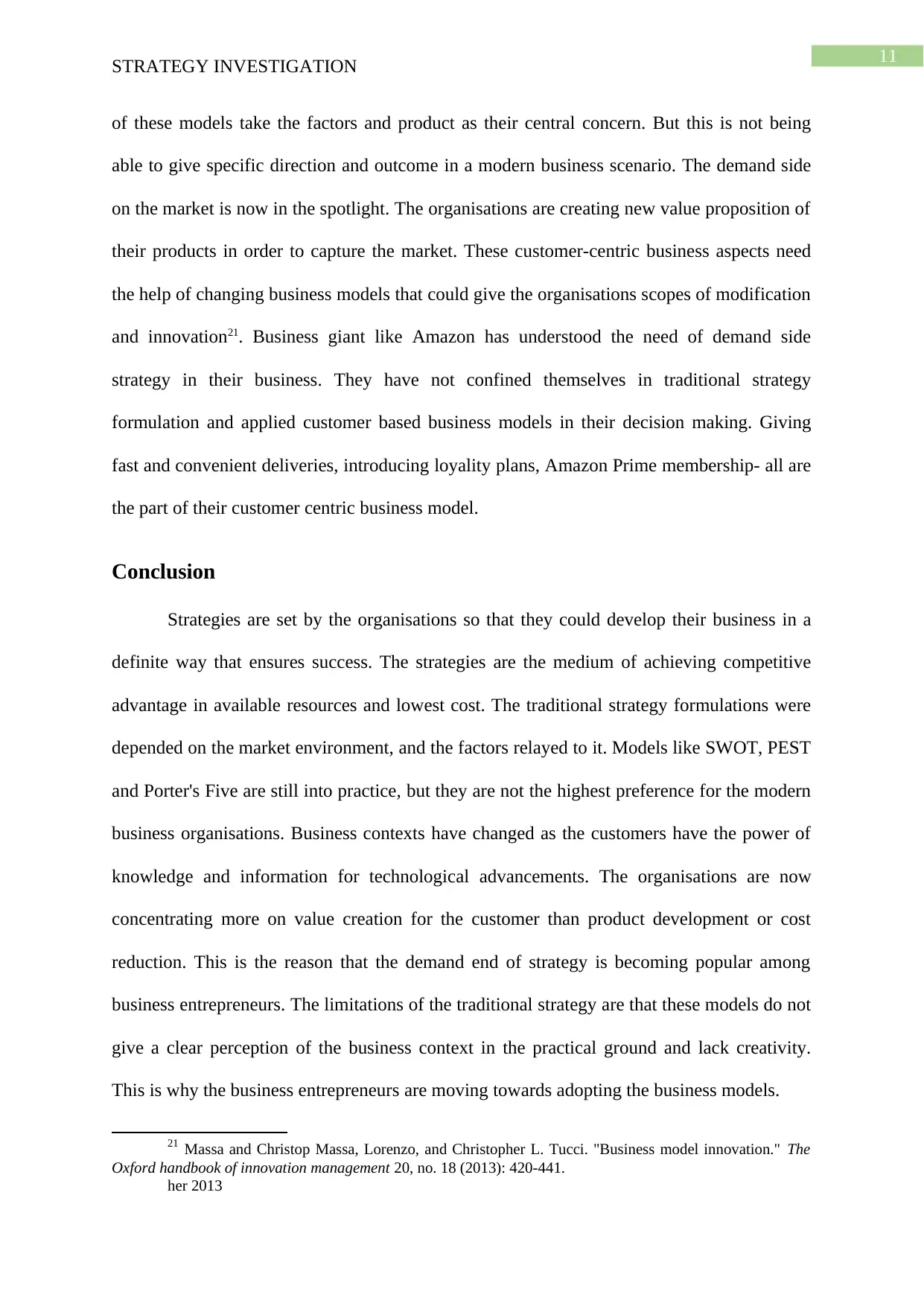
11
STRATEGY INVESTIGATION
of these models take the factors and product as their central concern. But this is not being
able to give specific direction and outcome in a modern business scenario. The demand side
on the market is now in the spotlight. The organisations are creating new value proposition of
their products in order to capture the market. These customer-centric business aspects need
the help of changing business models that could give the organisations scopes of modification
and innovation21. Business giant like Amazon has understood the need of demand side
strategy in their business. They have not confined themselves in traditional strategy
formulation and applied customer based business models in their decision making. Giving
fast and convenient deliveries, introducing loyality plans, Amazon Prime membership- all are
the part of their customer centric business model.
Conclusion
Strategies are set by the organisations so that they could develop their business in a
definite way that ensures success. The strategies are the medium of achieving competitive
advantage in available resources and lowest cost. The traditional strategy formulations were
depended on the market environment, and the factors relayed to it. Models like SWOT, PEST
and Porter's Five are still into practice, but they are not the highest preference for the modern
business organisations. Business contexts have changed as the customers have the power of
knowledge and information for technological advancements. The organisations are now
concentrating more on value creation for the customer than product development or cost
reduction. This is the reason that the demand end of strategy is becoming popular among
business entrepreneurs. The limitations of the traditional strategy are that these models do not
give a clear perception of the business context in the practical ground and lack creativity.
This is why the business entrepreneurs are moving towards adopting the business models.
21 Massa and Christop Massa, Lorenzo, and Christopher L. Tucci. "Business model innovation." The
Oxford handbook of innovation management 20, no. 18 (2013): 420-441.
her 2013
STRATEGY INVESTIGATION
of these models take the factors and product as their central concern. But this is not being
able to give specific direction and outcome in a modern business scenario. The demand side
on the market is now in the spotlight. The organisations are creating new value proposition of
their products in order to capture the market. These customer-centric business aspects need
the help of changing business models that could give the organisations scopes of modification
and innovation21. Business giant like Amazon has understood the need of demand side
strategy in their business. They have not confined themselves in traditional strategy
formulation and applied customer based business models in their decision making. Giving
fast and convenient deliveries, introducing loyality plans, Amazon Prime membership- all are
the part of their customer centric business model.
Conclusion
Strategies are set by the organisations so that they could develop their business in a
definite way that ensures success. The strategies are the medium of achieving competitive
advantage in available resources and lowest cost. The traditional strategy formulations were
depended on the market environment, and the factors relayed to it. Models like SWOT, PEST
and Porter's Five are still into practice, but they are not the highest preference for the modern
business organisations. Business contexts have changed as the customers have the power of
knowledge and information for technological advancements. The organisations are now
concentrating more on value creation for the customer than product development or cost
reduction. This is the reason that the demand end of strategy is becoming popular among
business entrepreneurs. The limitations of the traditional strategy are that these models do not
give a clear perception of the business context in the practical ground and lack creativity.
This is why the business entrepreneurs are moving towards adopting the business models.
21 Massa and Christop Massa, Lorenzo, and Christopher L. Tucci. "Business model innovation." The
Oxford handbook of innovation management 20, no. 18 (2013): 420-441.
her 2013
⊘ This is a preview!⊘
Do you want full access?
Subscribe today to unlock all pages.

Trusted by 1+ million students worldwide
1 out of 16
Related Documents
Your All-in-One AI-Powered Toolkit for Academic Success.
+13062052269
info@desklib.com
Available 24*7 on WhatsApp / Email
![[object Object]](/_next/static/media/star-bottom.7253800d.svg)
Unlock your academic potential
Copyright © 2020–2025 A2Z Services. All Rights Reserved. Developed and managed by ZUCOL.




